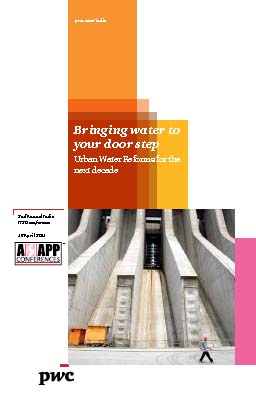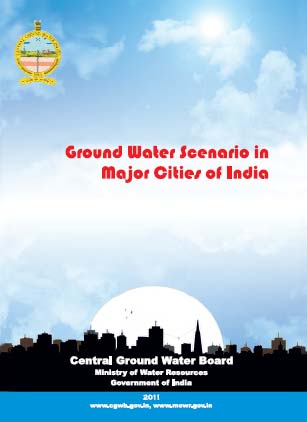Urban Water
Decentralised sustainable approach to sewage and waste water treatment for urban India
Posted on 31 May, 2011 03:17 PMthe small ponds, the lakes, the rivers flows into backwaters, the sea, and the wells catching the abundant rain water enabling such vegetation and greenery all around……
Water – also the factor, which brings the biggest of problems to urban life –
- mosquitoes,
- bad stench from clogged dirty canals,
- floods and water logging especially in the monsoons,
- roads breaking up because of poor drainage,
- drinking water scarcity in many parts of the city,
- water borne diseases and health problems
Using the metro lines in Bangalore for rainwater harvesting - Article by S Vishwanath
Posted on 27 May, 2011 12:29 PMAs the elevated tracks come up over the city a mass transport network called the metro is being built all over the city. In phases it is likely to cover over a 100 kilometre and become one of the prime modes of transport to the city. Apart from the transport benefits it will bring to the city there is one other potential benefit that could accrue to the city due to its construction.
The metro rail track offers a tremendous potential for rainwater harvesting. A total length of about 45 kilometres and a width of about 12 metres mean that the endowment of rainwater on the relatively very clean track with Bangalore’s rains of 970 mm annually is about 523 million litres. Considering a coefficient of runoff of 0.90 the harvestable rainwater is around 471 million litres annually. This could provide about 13,000 people with their annual requirement of water at 100 litres per day. A substantial sum.
Urban water supply sector – Key lessons and contextual sector risks – A note by Asian Development Bank
Posted on 22 May, 2011 08:56 PM The note complements ADB’s Guidance Note on Urban Water Supply Sector Risk Assessment and offers a framework for mapping governance risks to inform the preparation of future country partnership strategies.
The note complements ADB’s Guidance Note on Urban Water Supply Sector Risk Assessment and offers a framework for mapping governance risks to inform the preparation of future country partnership strategies.
Such a framework covers institutional aspects (policy, legal framework, and regulation); organizational aspects (planning, financial management, procurement, and human resources); and sector operations. While the note has identified entry points for mapping risks to development effectiveness in the sector, lessons from evaluations can augment ongoing efforts for mitigating these risks at institutional, organizational, operational, and project levels; and enhance the development effectiveness of ADB assistance in the sector.
Bringing water to your door step - Urban water reforms for the next decade – A report by Price Waterhouse Coopers
Posted on 20 May, 2011 09:01 PM This report by Price Waterhouse Coopers India Limited for the Second Annual India Water Conference in April 2011 presents its view on urban water reforms for the next decade. India is still at an early stage of the urbanisation process and will witness exponential growth in many of its cities over the next few decades. By 2030 the urban population is expected to reach more than 590 million. This will put enormous pressure on all existing resources, especially water. Despite sufficient availability of raw water, many of its cities struggle to provide more than a few hours of water supply.
This report by Price Waterhouse Coopers India Limited for the Second Annual India Water Conference in April 2011 presents its view on urban water reforms for the next decade. India is still at an early stage of the urbanisation process and will witness exponential growth in many of its cities over the next few decades. By 2030 the urban population is expected to reach more than 590 million. This will put enormous pressure on all existing resources, especially water. Despite sufficient availability of raw water, many of its cities struggle to provide more than a few hours of water supply.
Improving water availability in the cities requires addressing complex policy, institutional and funding challenges. The core of the new approach will include instituting a new era of greater accountability and a performance-driven approach. Service delivery to urban poor has to be an integral part of this approach to bring about greater inclusiveness.
Recent experience with Public-Private-Partnerships (PPP) in urban water supply shows that with a customer focused approach and demonstration of clear benefits, there will be greater political and public acceptability of private participation. At the same time, fiscal framework at the local level has to be considerably strengthened before attempting wide scale replication of PPP.
Peri-urban water security in a context of urbanization and climate change - A review of concepts and relationships by SaciWaters
Posted on 17 May, 2011 04:05 PM
It is a part of the peri-urban water security project discussion paper series that aims at having a collection of research papers relevant to the concepts and processes involved in the project that represent preliminary ideas circulated to encourage discussion and comments.
Though the relevant literature is cited at many places, this is not intended to be a literature review per se, but instead seeks to develop a shared framework to identify a set of common issues and questions that merit investigation.
The paper argues that peri-urban can be better understood in terms of its characteristics - a mix of agricultural and non-agricultural land uses, flows of goods, services and resources between villages and urban centers and a social profile that is very heterogeneous and in a state of flux. All these impact upon the local natural resource base, creating particular environmental and natural resource management problems that are often beyond the scope of urban or rural governments alone and require innovative ways of being addressed.
Groundwater scenario in major cities of India – A report by Central Ground Water Board
Posted on 17 May, 2011 10:35 AM It covers varying groundwater scenarios in the country including the highly developed metros, the hilly region, the coastal cities, the cities tapping unconsolidated and hard rock aquifers. The report briefly describes the administrative set up, status of water supply and demand, groundwater scenario, feasibility of rainwater harvesting and groundwater development strategy.
It covers varying groundwater scenarios in the country including the highly developed metros, the hilly region, the coastal cities, the cities tapping unconsolidated and hard rock aquifers. The report briefly describes the administrative set up, status of water supply and demand, groundwater scenario, feasibility of rainwater harvesting and groundwater development strategy.
It is an updated version of an earlier report on “Groundwater in urban environment in India” (2000). Since then, groundwater regime, urban demography and water demand have changed enormously. This report will form a scientific base for an in-depth understanding of urban groundwater system including aquifer geometry, water level behavior and groundwater quality. The possibility of artificial recharge to rejuvenate the urban aquifers has also been discussed.
Sustainable urban water supply in south India : Desalination, efficiency improvement, or rainwater harvesting?
Posted on 11 May, 2011 05:26 PMAbstract:
A hydrologic-economic modeling approach for analysis of urban water supply dynamics in Chennai, India
Posted on 11 May, 2011 05:21 PM
The goal is to reconstruct past system behavior and diagnose the causes of a major water crisis. In order to do this, we develop a hydrologic-engineering-economic model to address the complexity of urban water supply arising from consumers’ dependence on multiple interconnected sources of water.
Factors determining informal tanker water markets in Chennai - Blog post by Veena Srinivasan
Posted on 11 May, 2011 05:15 PMIn these, private tanker truck operators transport water extracted from peri-urban wells to urban consumers. This study adopted a systems modeling approach to analyzing the informal tanker market in India. The results indicate that the demand for tanker supply was caused by lack of groundwater availability in private wells as well as unreliable piped supply.
River bank filtration in Uttarakhand - Blog post by Neelima Garg
Posted on 11 May, 2011 02:30 PMProcess of River Bank Filtration technology
Pumping induces seepage from the surface water into the aquifer and results in quality improvements enroute to the well by natural processes such as filtration, biodegradation, adsorption, redox reactions and mixing. RBF can also occur under natural conditions as a result of an influent river.



